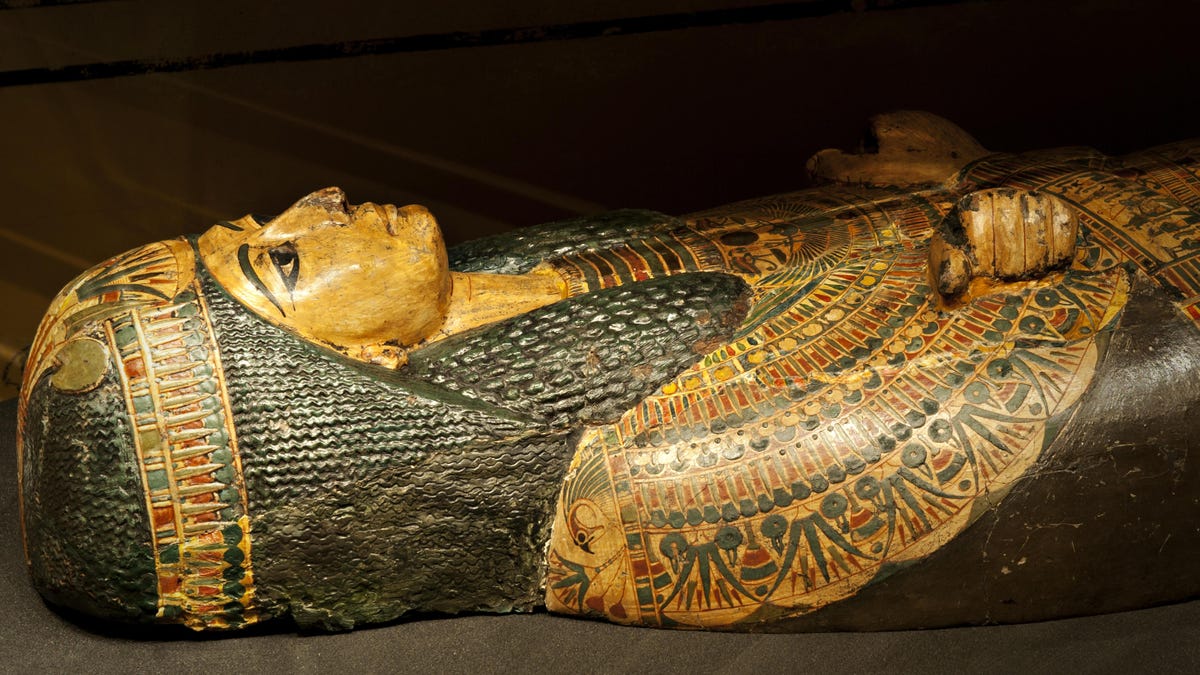3,000-year-old Egyptian mummy 'speaks' with 3D-printed vocal tract
Scientists build a 3D-printed vocal tract to give an ancient Egyptian priest the ability to speak again.

Nesyamun's coffin, on display at the Leeds City Museum
At the gigantic Temple of Karnak in ancient Thebes, around 3,000 years ago, a priest named Nesyamun practiced under Egyptian pharaoh Ramses XI. He would feed grain to sacred cattle offered to the God Amun and had the rare opportunity to read and write, as a scribe. When he died, his body was mummified and encased in a tomb that formed part of the Theban Necropolis.
Because Nesyamun's body is so exquisitely preserved, he has been the subject of many investigations by scientists and researchers since arriving at Leeds Museum in 1823. Extensive autopsies and X-rays have revealed much about his life and a history of disease, but it's the latest round of examination that we really want to shout about.
A new study, published in the journal Scientific Reports on Wednesday, details the creation of a 3D-printed vocal tract from state-of-the-art CT scans of Nesyamun's body. A collaboration of UK and German scientists used these incredibly accurate scans to visualize the larynx -- or "voice box" -- and throat of Nesyamun on a computer. This allowed them to create the 3D model of the ancient priest's vocal tract and place it over a loudspeaker that mimics the sound a human larynx can produce.
Read more: The best 3D printers in 2020 for beginners and budget creators
"We hear a vowel-like sound that would come from Nesyamun's mouth if his mouth were in its current position and he were alive," said David Howard, an electronic engineer at Royal Holloway University of London and first author on the paper.
The vocal sound falls between the vowels in the English words "bed" and "bad," according to the paper. Upon hearing the sound, my first question was, "what am I listening to?" But it's important to note this is one vocal sound for a single vowel -- it hasn't re-created running speech for Nesyamun.
"Vowels in different languages can be different, and his tongue has lost some of its bulk over the years, but the sound is accurate for his extant vocal tract shape," Howard notes.
There are some caveats that may change Nesyamun's vocal output: His mummified body was discovered with its mouth open (unusual for mummification processes), and parts of his mouth are missing. His vocal tract position is also re-created based on his burial position -- rather than for any specific sound.
The work re-creating Nesyamun's voice was aided by a pioneering device Howard created in 2014, known as the Vocal Tract Organ.
"The Vocal Tract Organ, a first in its own right, provided the inspiration for doing this," Howard said.
The creepy-looking device acts a musical instrument that utilizes 3D printed vocal tracts to create specific vowel sounds. Line up a number of the printed vocal tracts and you've got yourself a new way to play music. You can see the unusual prototype machine in action here.
Researchers have tried to re-create voices of ancient humans, including the famed 5,300-year-old Ötzi the Iceman, a mummified corpse discovered in the Italian Alps in 1991. This team performed similar computational work on Ötzi as Howard's team did on Nesyamun, but used digitally-recreated vowel sounds to approximate the man's voice. The Vocal Tract Organ provided a new way to recreate sounds.
The team suggest the innovative way of reconstructing vocal sounds has "implications for the way in which the past is presented to the public."
Originally published 8 a.m. PT

